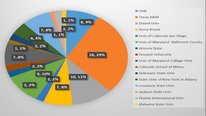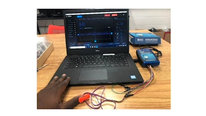Broadening STEM Participation at HBCUs
NSF Awards: 2011926
2021 (see original presentation & discussion)
Undergraduate
The video will discuss a culturally responsive intervention program developed by Dr. Picho-Kiroga, to improve metacognitive and emotion regulation skills, both of which represent important pathways to attenuating psychosocial factors that impair problem solving skills, specifically, Social Identity Threat.
Science, Engineering, Technology
Howard University
Historically Black Colleges and Universities - Undergraduate Program (HBCU-UP)
Related Content for STEMMING the Tide in STEM
-
 2016Underrepresented Minority Student Perspectives of Challenges
2016Underrepresented Minority Student Perspectives of Challenges
Shabnam Etemadi
-
 2021Experiment-centric Pedagogy in STEM During COVID-19 Pandemic
2021Experiment-centric Pedagogy in STEM During COVID-19 Pandemic
Oludare Owolabi
-
 2016An Exploration of Best Mentoring Practices of STEM Program
2016An Exploration of Best Mentoring Practices of STEM Program
Germysha Little
-
 2018Nanowires
2018Nanowires
Surya Nalamati
-
 2021You Deserve A Seat at The Table: The Data Economy Workforce
2021You Deserve A Seat at The Table: The Data Economy Workforce
Junell McCall
-
 2018The Road to Persistence in STEM: HBCUs in Action
2018The Road to Persistence in STEM: HBCUs in Action
Shabnam Brady
-
 2018Freshmen Doing Research: Broadening Participation
2018Freshmen Doing Research: Broadening Participation
Diane Smoot, Ph.D.
-
 2019vObjects: Taking the pressure of learning Thermodynamics
2019vObjects: Taking the pressure of learning Thermodynamics
Diana Bairakatrova
This video has had approximately 229 visits by 165 visitors from 106 unique locations. It has been played 109 times as of 05/2023.
Map reflects activity with this presentation from the 2021 STEM For All Video Showcase website, as well as the STEM For All Multiplex website. 
Based on periodically updated Google Analytics data. This is intended to show usage trends but may not capture all activity from every visitor.
show more
Discussion from the 2021 STEM For All Video Showcase (19 posts)

Stephen Alkins
Diversity, Equity, and Inclusion Officer
This sounds like a great tool to help underrepresented students and faculty members cope, process, and navigate through cultural stereotypes, almost like building GRIT. How does STRIP distinguish from this approach in terms its emotional regulation or executive functioning strategies?
Could you say a bit more about what techniques are suggested in STRIP. Also, does STRIP provide any guidance on institutional change advocacy?
I'd like to hear more about the details of the program (e.g. where did you pilot? was this program only for students or were faculty considered also? what are some of your preliminary results about the efficacy of the tool? what is the difference for a woman of color student or faculty at an HBCU versus a PWI?).
Great presentation!
James Callahan
Katherine Picho-Kiroga
Assistant Professor
Hi. Thanks!!
STRIP is totally new so it's still in the efficacy testing phase. We conducted mixed methods and hope that some of the qualitative findings might be able to inform context in STEM environments (but not necessarily institutional change--- that might be further down the road).
STRIP focuses only on students at the moment (women and students of color); Piloted at Howard University' with Engineering and computer science students. An efficacy study is still in progress until next year, when we will have more comprehensive data.
Our first wave of data collection was just completed this spring. We hope to analyze these data during the summer and preliminary results should be available by October some time. Accordingly, seeing as it is in its first phase of testing, the program has only been rolled out at HBCUs. Eventually we will test it at PWIs and then we will have information on differences in program efficacy across the different types of institutions.
STRIP metacognition entails:
1. Teaching planning, monitoring and evaluation skills through engineering design projects. The main is on honing metacognitive monitoring skills, which tend to be hijacked during stereotype threat. Students work in groups on engineering design projects (ill-structured). Each project requires that they plan (before executing task); execute task and then evaluate their performance (metacog cycle).
They engage in each part of the process unscaffolded- for us to get baseline. Then they use what they've learned about planning, monitoring etc...during the engineering design cycle. Practice of these skills is scaffolded at first, and then supports gradually removed. Students engage in 'reflection' at the end of each design cycle- to allow us to capture/ evaluate how well they have applied the skills. These collective reflections and quality of student work are compared against a control group that did not receive the intervention.
Emotion regulation involves teaching students practical skills on how to engage in adaptive emotion regulation skills when they experience negative emotions: The 2 main strategies are cognitive reappraisal &, psychological distancing (distancing includes 4 tactics, among them-- Taking a perspective that creates space between you & the stimulus (spatial); Taking a perspective in which the stimulus is more distant in time (temporal); Taking the perspective of a neutral 3rd party regarding the situation (objective). The 3rd strategy is complementary to reappraisal and distancing and enhances the benefits of these 2- it's attentional regulation-- which involves consciously directing attention to focus on selective information in order to magnify the
experience of a specific (desired) stimulus.
James Callahan
Nuria Jaumot-Pascual
Research Scientist
This sounds like a really interesting tool to support broadening participation. Can you talk a little bit about what types of activities that the program uses to improve metacognitive and emotion regulation skills?
From what I can see in the video, these are interventions that are directed to women and URMs. Does the program include any interventions to change the social and cultural environments where women and URMs endure stereotype threat?
James Callahan
Katherine Picho-Kiroga
Assistant Professor
Hi Nuria
I've provided extensive details in the first question above--posed by Stephen Alkins, please read my response to him. If you need more details above and beyond that, let me know.
Context is very important, and it's my next direction in this line of research. The intervention addresses the individual psychological factors implicated in activating and sustaining stereotype threat...but I'm currently working on research to uncover key factors in context that could be used to intervene at contextual level. In fact, I have-- and I'm currently working on a teacher intervention version of STRIP- to improve the immediate context-- classrooms. It's an intervention for teachers. The idea is that if we can have a dual intervention- where teachers improve class/ learning contexts and students have taken and can apply STRIP-- that dual type intervention would be more effective than just intervening at the student level. SO...in short...this is a project in the works....
thank you for your interest!!
James Callahan
Laura Seifert
Laura Seifert
Hello Professor Picho-Kiroga - I am very interested to learn more about the outcomes of your teacher intervention research. Is the best way to do that by checking in on the RISE lab website periodically? Best wishes to you as you continue this very promising line of research!
James Callahan
Katherine Picho-Kiroga
Assistant Professor
HI Laura
The work is in its nascent stages, but super excited about it as you are.
Yes best way would be to check the website or to email me. I dont suppose there will be much new in the next 9 months. In about a week or so my website should have a subscribe button where you can sub for alerts/ updates. That may be the best way to keep abreast on this topic. Thanks again for your interest!
KP
Laura Seifert
James Callahan
Overtoun Jenda
Assistant Provost and Professor of Mathematics
This looks very promising. Thanks for sharing. Are there specific interventions that you have implemented? How many students and faculty are participating in your program? Have you conducted any surveys to measure effectiveness of the program so far? Is the tool you have developed discipline dependent? Really interesting program.
James Callahan
Katherine Picho-Kiroga
Assistant Professor
Hi Overtoun
Thank you.
I think I've answered your questions in the first 2 responses...but briefly...
It's a student intervention. No faculty. I facilitated all the teaching/ for the intervention.
We have not evaluated yet as we just completed data collection (phase 1)-- there are 2 phases. And the data are yet to be analyzed. Please if you dont mind, read responses to the first two individuals who asked questions. Your questions are thoroughly addressed there...but maybe I will copy and paste to the discussion as well so that you have access to it.
James Callahan
James Callahan
Dr. Katherine Picho-Kiroga,
We are very pleased to learn of your very import program at Howard University. My colleagues and I will be enthusiastically reading up on the STRIP(S) program and RISE Lab.
We're particularly interested in learning more of the scope of your work work with educators and students at the K-12 level and in the wider communities. Howard University programs play such a powerful role; we love to work with colleagues at Howard.
As Washington DC and Montgomery County in Maryland is one of our geographic bases, we know first hand what a difference Howard's connection with the community in STEM can be.
Mobile Climate Science Labs educators teach in the local DC and MD schools, and bring STEM into the communities on a broad scale. In the same ways that have worked well in California over the last 20 years, we are now STEM presenters at events such as the US Science and Engineering Festival (at the DC convention center) and the Anacostia Environmental Youth Summit. Our students have projects with a focus on the National Museum of African American History and Culture.
It has been wonderful sharing booths with Howard University programs at large STEM events in Washington DC, such as at the American Association for Advancement of Science Family Science Days:
https://www.youtube.com/watch?v=c3v6PMTgppw&...
With that in mind, you'll see why we are so eager to learn from you. The RISELab addresses so many of the vital issues that have been central in our work for the last two decades.
Thank you for bringing this beautiful and essential video to the Showcase!
James Callahan
Katherine Picho-Kiroga
Assistant Professor
Hi James
Thanks for stopping by and for sharing your important work as well. Happy to connect with you at some point to learn more about your program!!
James Callahan
Katherine Picho-Kiroga
Assistant Professor
Hi James
Thank you for sharing your video!! And thank you for stopping by...happy to connect at some point since our work does have some overlap!! Keep going! You work is very important. I should be adding a subscribe button to the riselab website so you can check for updates or just email me when you get a chance.
James Callahan
John Coleman
I am intrigued by the content of your video, and concur with your assessments. Based on my experience, perceived gender and racial biases impact African American students’ view of STEM as a potential career. Therefore, as STEM faculty, we work not only to impart STEM course content excellence, but also serve as mentors. We aim for activities that build self-efficacy, and try to prepare students to succeed at PWI institutions, where many go for advanced degrees.
I’d like to hear more about STRIP, as it seems to be a tool that could be very helpful in our endeavors. Thank you for sharing.
Sarah Kirk
Thank you for this important work. I wonder if you believe that your approach might also be helpful for marginalized faculty that have already persisted in the field but continue to face both micro and macroagressions?
Katherine Picho-Kiroga
Assistant Professor
Hi Sarah
No...I dont think it would apply as is currently. I think for professionals a different approach would be required...and I'm in the initial stages of examining social identity threat in occupational spaces and figuring out what interventions might be better at that level.
Natalie Stapert
Dr. Picho-Kiroga,
Wow! Your work is so important. Stereotyping and stereotype threat are constantly limiting the talent pool for STEM jobs and keeping the sciences from advancing as quickly and creatively as possible. As a middle school teacher, I believe that STRIP intervention is important at an early age. By the time students reach high school and college, many talented young people have already left the sciences. Would it be possible to adapt STRIP for younger students? If you wanted to try your research with middle school students, please reach out! I would be thrilled to work with you.
Katherine Picho-Kiroga
Assistant Professor
Hi Natalie
YES!! These skills would be most beneficial earlier on so definitely middle school is a great area especially since the gender gaps begin around that stage. I'd LOVE to try this out with middle school students...The program could be very easily adapted. Let's connect.
Please email me: katherine.picho@howard.edu.
Would love to work with you on this and thank you for your interest in my work.
Neil Heffernan
This seems really important! Bravo! Dying to see the results of the experiment!
Katherine Picho-Kiroga
Assistant Professor
Thank you! Will keep you posted!
Gloriana Lopez
Great presentation!
I was wondering how you see the role of community in the retention and degree completion among women and ethnic minorities?
Further posting is closed as the event has ended.